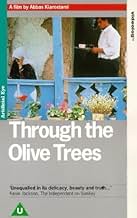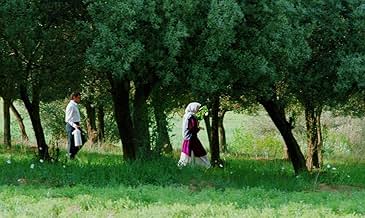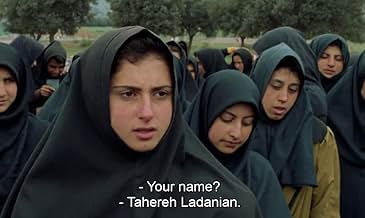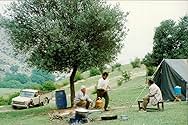VALUTAZIONE IMDb
7,7/10
11.002
LA TUA VALUTAZIONE
Una rappresentazione della relazione fuori campo tra una coppia di attori che interpretano gli sposi novelli.Una rappresentazione della relazione fuori campo tra una coppia di attori che interpretano gli sposi novelli.Una rappresentazione della relazione fuori campo tra una coppia di attori che interpretano gli sposi novelli.
- Regia
- Sceneggiatura
- Star
- Premi
- 5 vittorie e 6 candidature totali
Ostadvali Babaei
- Teacher
- (as Astadouli Babani)
Nosrat Bagheri
- Achiz
- (as Nasret Betri)
Khodabakhsh Defaei
- Teacher
- (as Kheda Barech Defai)
Hossein Jafarian
- Hossein
- (non citato nei titoli originali)
Jafar Panahi
- Panahi
- (non citato nei titoli originali)
Recensioni in evidenza
I like the work Abbas Kiarostami had done. He focusses on things which we ignore, the common aspects of life, only we have have the eyes we can see much more. He does this again and again. It is in these moments where actually life happens which we humans tend to igmore so often that it is cruel.
As for the ending, it kind of is open, but how fast the boy ran at the end, I tend believe it is because of the happiness. But it is really upto you how you percieve this, as you are the man at the mountain who saw this, not knowing the conversations.
As for the ending, it kind of is open, but how fast the boy ran at the end, I tend believe it is because of the happiness. But it is really upto you how you percieve this, as you are the man at the mountain who saw this, not knowing the conversations.
10Red-125
Reviewer's Note: The Iranian movie Zire darakhatan zeyton (1994) was shown in the U.S. with the title Through the Olive Trees. The film was written and directed by Abbas Kiarostami.
The movie is the third of a series of films entitled "The Koker Trilogy." Koker is a small village 200 miles northwest of Tehran. No one outside Iran would know anything about Koker, except for Kiarostami's films. He used Koker as the setting for the first film in the trilogy-Where is the Friend's House? (1987). (This is an amazing movie, with an IMDb rating of 8.1.) However, Koker was still just an obscure village.
Koker is now famous because of a horrible tragedy that took place in the region on June 21, 1990. A devastating earthquake destroyed Koker and many surrounding villages. The loss of life was immense--about 50,000 people died, including 20,000 children. Almost all the buildings were destroyed. Kiarostami directed two more films about Koker. Now, the location is well known to Iranians and cinephiles.
In real life, director Kiarostami and his son traveled to Koker five days after the earthquake occurred. They wanted to find out if the two brothers who starred in the first film had survived the earthquake. Kiarostami turned his trip into a movie. That film was And Life Goes On (1992). He found that despite the immense grief felt by the local people, life did, indeed, go on.
Through the Olive Trees stars Mohamad Ali Keshavarz as The Film Director. He's the only professional actor in any of the three movies. As is usual for Kiarostami, the other actors are local amateurs. Farhad Kheradmand plays Farhad. He was also in And Life Goes On. Zarifeh Shiva portrays Mrs. Shiva, who is the director's assistant.
In this film, Kiarostami has made a movie about making a movie. The movie they are making is And Life Goes On. There's no shortage of movies about making movies. However, I've never seen a movie about making a movie that already exists. It's a brilliant concept, because we can recognize segments of And Life Goes On as they appear in Through the Olive Trees.
However, Through the Olive Trees is really about the relationship of two young people. Hossein Rezai portrays Hossein, who had a four-minute, but important, segment in And Life Goes On. In that segment, he tells us that he and his wife were married the day after the earthquake. They were engaged, the wedding had been planned, and they went ahead with it. This demonstrated a key element of And Life Goes On--the couple embodied the human desire to pick up the pieces and move forward with life, and with replacing death with new life.
In this movie, we learn that Hossain has fallen in love with the woman who played the young wife--Tahereh. However, Tahereh (portrayed by Tahereh Ladanian) apparently wants nothing to do with Hossain. Tahereh lost both of her parents in the earthquake, so she now lives with her grandmother. Her grandmother absolutely rejects Hossain because he's illiterate and doesn't own a house. That makes sense, except that Hossain is intelligent and ambitious, and truly loves the young woman.
So, what we have is a plot within a movie about making a movie. It sounds confusing, but it works.
Kiarostami is famous for using panoramic long shots, and this is what we see at the end of the film. The closing long shot is amazing and unforgettable, but ambiguous.
This is an amazing movie. It has an extremely high IMDb rating of 7.8. I rated it 10. It worked well enough on the small screen, but of course it would be better in a theater. We saw it on a Criterion DVD, sold with the other two movies in the trilogy. The films may be available separately, which would be OK. However, the Criterion edition has many video extras, along with a written essay by noted film critic Godfrey Cheshire.
I would say that the three trilogy movies are all must-see films if you love great international cinema. Find them and watch them.
IMPORTANT: The trilogy should be seen in order of production: Where is the Friend's House? then, And Life Goes On, then, Through the Olive Trees. The movies will each work separately, but they won't work as well if seen out of that order.
The movie is the third of a series of films entitled "The Koker Trilogy." Koker is a small village 200 miles northwest of Tehran. No one outside Iran would know anything about Koker, except for Kiarostami's films. He used Koker as the setting for the first film in the trilogy-Where is the Friend's House? (1987). (This is an amazing movie, with an IMDb rating of 8.1.) However, Koker was still just an obscure village.
Koker is now famous because of a horrible tragedy that took place in the region on June 21, 1990. A devastating earthquake destroyed Koker and many surrounding villages. The loss of life was immense--about 50,000 people died, including 20,000 children. Almost all the buildings were destroyed. Kiarostami directed two more films about Koker. Now, the location is well known to Iranians and cinephiles.
In real life, director Kiarostami and his son traveled to Koker five days after the earthquake occurred. They wanted to find out if the two brothers who starred in the first film had survived the earthquake. Kiarostami turned his trip into a movie. That film was And Life Goes On (1992). He found that despite the immense grief felt by the local people, life did, indeed, go on.
Through the Olive Trees stars Mohamad Ali Keshavarz as The Film Director. He's the only professional actor in any of the three movies. As is usual for Kiarostami, the other actors are local amateurs. Farhad Kheradmand plays Farhad. He was also in And Life Goes On. Zarifeh Shiva portrays Mrs. Shiva, who is the director's assistant.
In this film, Kiarostami has made a movie about making a movie. The movie they are making is And Life Goes On. There's no shortage of movies about making movies. However, I've never seen a movie about making a movie that already exists. It's a brilliant concept, because we can recognize segments of And Life Goes On as they appear in Through the Olive Trees.
However, Through the Olive Trees is really about the relationship of two young people. Hossein Rezai portrays Hossein, who had a four-minute, but important, segment in And Life Goes On. In that segment, he tells us that he and his wife were married the day after the earthquake. They were engaged, the wedding had been planned, and they went ahead with it. This demonstrated a key element of And Life Goes On--the couple embodied the human desire to pick up the pieces and move forward with life, and with replacing death with new life.
In this movie, we learn that Hossain has fallen in love with the woman who played the young wife--Tahereh. However, Tahereh (portrayed by Tahereh Ladanian) apparently wants nothing to do with Hossain. Tahereh lost both of her parents in the earthquake, so she now lives with her grandmother. Her grandmother absolutely rejects Hossain because he's illiterate and doesn't own a house. That makes sense, except that Hossain is intelligent and ambitious, and truly loves the young woman.
So, what we have is a plot within a movie about making a movie. It sounds confusing, but it works.
Kiarostami is famous for using panoramic long shots, and this is what we see at the end of the film. The closing long shot is amazing and unforgettable, but ambiguous.
This is an amazing movie. It has an extremely high IMDb rating of 7.8. I rated it 10. It worked well enough on the small screen, but of course it would be better in a theater. We saw it on a Criterion DVD, sold with the other two movies in the trilogy. The films may be available separately, which would be OK. However, the Criterion edition has many video extras, along with a written essay by noted film critic Godfrey Cheshire.
I would say that the three trilogy movies are all must-see films if you love great international cinema. Find them and watch them.
IMPORTANT: The trilogy should be seen in order of production: Where is the Friend's House? then, And Life Goes On, then, Through the Olive Trees. The movies will each work separately, but they won't work as well if seen out of that order.
I saw the movie while on vacation in Sweden. Just clicking through TV channels, I stopped on this movie accidentally, initially not paying much attention to it. But the images started to attract me, finally they got hold of me. The realism of everyday life with some strange air of poetic aura was fascinating. The action just floats like a river, no big happenings but pictures are dense, close to skin, close to feelings. The people dreams pour out into daily life. The shaky balance between reality and a dream culminates in the last sequence and we hope for an answer, which is not disclosed but we are left to search it in our imagination and in our dreams evoked by this wonderful movie. Maybe longing for an answer is all what is possible.
This epoch-making poem opens with a film crew trying to cast for a movie in a provincial village, in the aftermath of A DEVASTATING EARTHQUAKE which has claimed many, many lives. We then are shown that the remaining people are trying to rebuild their lives, picking up bits and pieces of the past, but with an eye to the future.example of these people are the boy and the girl who are selected to play the protagonists of the melodrama to be made. The crew's interest interest in these people is limited to their role and usefulness for director's vision of the film, and no more. But-and this is a crucial BUT-the boy and the girl have their own agenda, and don't care very much for the screenplay dictated by the director (for instance repeated takes of the tea-serving scene): The girl wants to wear colorful and jolly dress, and the boy wants to be able to love her. Eventually, the boy follws the girl into the magnificent ending shot of the expanse of the olive groves, and into the ubncertain but potentially hopeful future. Will life, love and color be able to vanquish darkness and death? Will the boy and the girl find the courage and and power to fire the crew, the director, the casting agent , down to the ticket-vendor and become subjects of their own life and destiny? ... This is to be continued.........
This is the art movie in its essence. Every single minute of this movie is complexly detailed. It was considered by the critics a masterpiece but it could not be nominated for the Academy Awards in the 'Foreign Language Category' because of political problems between Iran and USA at the time (but in 99 'Children of Heaven' was nominated).
It was written by Abbas Kiarostama, who also wrote 'The White Balloon' (another great film) and 'Taste of Cherry' (not so good, although it won the Cannes Palm D'or).
This is a must see for any fan of artfilms. Simply fantastic, amazing and everything else, this movie is a 'sea of creativity'.
It was written by Abbas Kiarostama, who also wrote 'The White Balloon' (another great film) and 'Taste of Cherry' (not so good, although it won the Cannes Palm D'or).
This is a must see for any fan of artfilms. Simply fantastic, amazing and everything else, this movie is a 'sea of creativity'.
Lo sapevi?
- QuizThe first film in which Abbas Kiarostami has hired a professional actor (Mohamad Ali Keshavarz who plays the director of the film-within-the-film).
- ConnessioniFeatured in Cinema Iran (2005)
I più visti
Accedi per valutare e creare un elenco di titoli salvati per ottenere consigli personalizzati
- How long is Through the Olive Trees?Powered by Alexa
Dettagli
Botteghino
- Lordo Stati Uniti e Canada
- 40.300 USD
Contribuisci a questa pagina
Suggerisci una modifica o aggiungi i contenuti mancanti

Divario superiore
By what name was Sotto gli ulivi (1994) officially released in India in English?
Rispondi





















